o 2
n
t/5
w >
C/5
ffl
Secondly, as explained above, behavioural change requires awareness, and the parents and others who can be recruited to help are needed to achieve this awareness. During the first three or four days of intensive treatment the child is never to be left alone, not even for a second in difficult situations. This needs planning, as supervi足 sion is required day and night. It is useful for turns to be taken a rota can be drawn up, and all involved need to understand the principles of what is required, and have available, as well as to contribute to, the list of suggestions for adaptive ways of coping with difficult situations. When the sleeping child is seen to be scratching, the watching adult gently takes the child from the bed and, holding the hands away from the skin, gives a hug and if necessary offers a distraction to calm and settle. As well as responding appropriately to difficult situations, it is equally if not more important for praise, support and encouragement to be given when scratching is not occurring, especially when the child is actively practising an adaptive response themselves. In summary, there are 12 important rules for parents, six more general and six essentially practical (Fig 5.12). Once the first three or four days have been successfully accomplished, the first phase of treatment continues with attention being applied especially to continuing treatment at Levels 1 and 2, emollients and topical steroids. Awareness of any self-damaging behaviour remains important and vigilance with continuing appropriate positive intervention is necessary, but gradually the intensity of this particular behavioural focus can lessen. As the skin heals the success of the treatment approach needs
